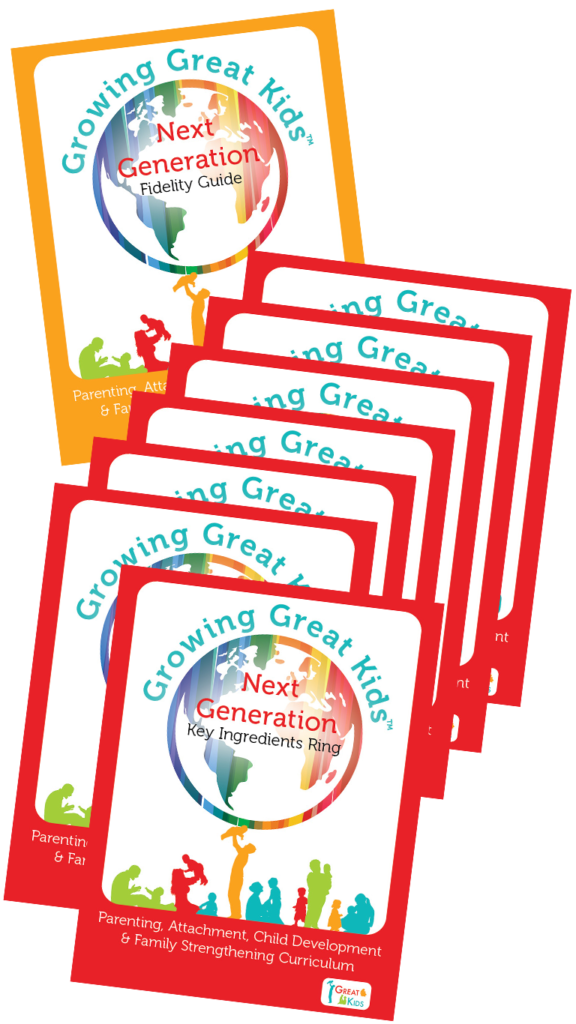The holidays are exciting times of the year for parents and children, but it can also be very stressful if safety is not included on the top of the list of a family’s holiday priorities. Today’s blog is devoted to tips and recommendations for keeping infants and young children safe while enjoying celebrations, gatherings, traveling, shopping trips and more. Did you know that the Growing Great Kids Curriculum includes conversation guides to explore preventive safety practices? Today we will review them and discuss how to use them, so parents get the most out of those conversations. We will conclude with a few national/hotline resources that could be shared with parents during your December home visits in preparation for the holidays.
There are many safety dangers for infants and young children during the holidays including: unsupervised exposure to Christmas trees, lights, decorations, food, fireplaces and kitchen appliances. Toys, travel, unfamiliar pets and shopping pose increased risks for young children during the holiday season. To help ensure a safe holiday season, Great Kids, Inc. and the American Academy of Pediatrics provides the following recommendations (HealthyChildren.org, 2015):
Christmas Tree
- When purchasing an artificial tree, make sure it’s fire resistant, and if it is used be sure the lights are in proper working order. When buying a live tree, check for freshness. When setting up the tree, place it away from fireplaces, radiators, or portable heaters. Place the tree out of the way of traffic and do not block doorways. Hang ornaments above your child’s reach to prevent trees falling over and/or fragile ornaments from breaking in the child’s hands. If your baby is crawling or walking, consider putting a protective fence around the tree.
Holiday Lights
- Check all lights for safety before hanging them. Position cords to be out of the reach of infants and young children. Never use electric lights on a metallic tree. The tree can become charged with electricity from faulty lights, and a person touching a branch could be electrocuted. Make sure lights themselves are out of the reach of your children. And, turn off all lights when you go to bed or leave the house.
Decorations and Gift Wrapping
- Use only decorations that are child-friendly, non-breakable that are made from non-combustible or flame-resistant materials. Avoid decorations that have sharp edges anddecorations that resemble candy or food as children may be tempted to eat them.
- Remove any wrapping papers, bags, ribbons, and bows after gifts are opened. These items may cause suffocation and/or choking hazards.
- Keep holiday plants that may be potentially poisonous away from children.
Candles
- Purchase “flameless”, battery operated candles. It is best not to use lighted candles anywhere, and especially not on or near a tree or wreath. If you are visiting a home in which candles are burning, be certain they are out of the reach of your child.
Toys
- Young children frequently swallow and/or choke on small, toxic batteries and little game/toy pieces. Check all toys and their packaging, removing small parts and loose batteries before allowing your child to play with the toy.
- Balloons are not safe for young children to play with because they can choke or suffocate on uninflated or broken balloons.
- Remove tags, strings, and ribbons from toys before giving to young children. Toys with strings that are more than 12 inches in length are not safe for infants because they pose a strangulation hazard for babies.
Foods and beverages
- Be sure to keep alcoholic beverages, foods unsafe for infants/toddlers to consume and hot liquids and foods away from the edges of counters and tables, where they can be consumed or easily knocked over by a young child’s exploring hands.
- Fully cook meats and poultry, and wash raw vegetables and fruits to remove bacteria.
- Never allow young children to be close to kitchen appliances when they are in use.
Travel
- Always make sure your infant/young children are secured in an weight-appropriate child safety seat, booster seat, or seat belt, insuring that the safety seat has been correctly positioned and secured.
- Never drive under the influence of alcohol or drugs.
- Be careful when driving at night especially during the holidays, there is a higher incidence of impaired driving.
Shopping
- Never leave your child unattended. While shopping, pay attention to where your child is, what is happening at the moment and be mindful of how you and your infant/young children are feeling about the experience. If your child is sending ‘I’ve had enough or I’m hungry or tired signals, “it’s time to take a break or go home.
Holiday Gatherings
- Try to stick to your child’s usual routines, including sleep and eating schedules.
- Decrease stranger anxiety by keeping your infant at a safe distance from people. Infants and young children often get overwhelmed when exposed to many people, lights, sounds, and activities without a break and quiet times in between.
- Wash your hands frequently. Make sure your children, and anyone who wants to hold your baby, does the same.
- During cold and flu season, to prevent your baby from catching a cold or the flu, do not encourage others to touch, breathe on or hold your baby. Instead encourage them to interact with the baby from a safe distance.
For general infant-child safety tips and conversation guides included in the Growing Great Kids curriculum, Home Visitors can check out the following references:
- 0-3-month Infant Safety. This module subsection provides safety references and handouts around sleeping, clothing, toys, baby equipment, feeding, health, and safety in general.
- 7-9-month Home Safety Checklist for Families with babies 6 months and older.
- 10-12-month Preventing Toddler Injuries. This subsection explores common injuries toddlers experience and how to prevent them.
- 13-15-month Safe and Healthy Environments for Toddlers
- 25-30-month Car Safety
Home visits during the holiday season are an ideal time for planning to incorporate discussions around preventive safety practices. The Growing Great Kids conversation guides are presented using a strength-based, solution-focused approach to support parents as they enhance their child safety critical thinking and problem-solving abilities.
And, you might want to remind financially stressed parents that a child’s best gift is feeling safe & secure, love & valued and curious & capable…The only costs associated with this gift are the parent’s time, effort and love.
The following sources include additional, useful holiday tips for child safety. Check them out and pass them on to families:
- The Centers for Disease Control and Prevention provides 12 Ways to Have a Healthy Holiday Season, visit http://www.cdc.gov/features/healthytips/index.html
- KidsHealth.org provides the National Poison Center phone number, visit http://kidshealth.org/
- The US Consumer Product Safety Commission provides information on toy safety and general safety tips for the holiday season https://www.cpsc.gov/
Works Cited:
HealthyChildren.org (November 17, 2015). Healthy Children: Holiday Safety and Mental Health Tips. Retrieved from https://www.healthychildren.org/English/news/Pages/Holiday-Safety-Tips.aspx

